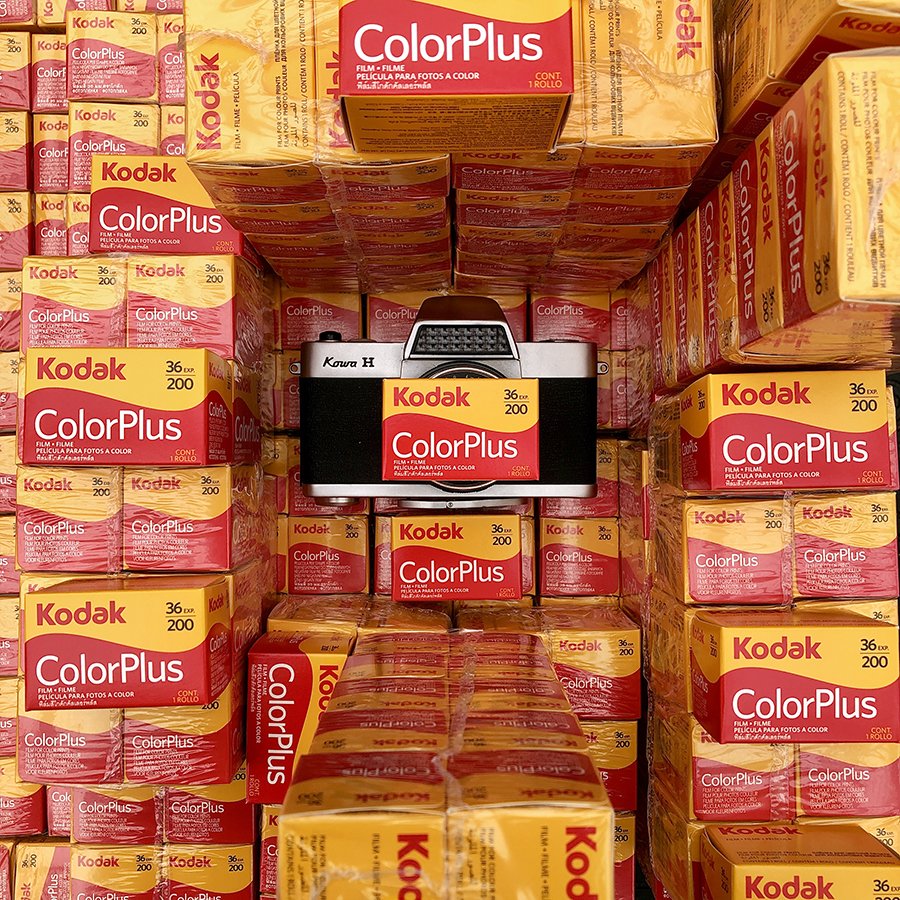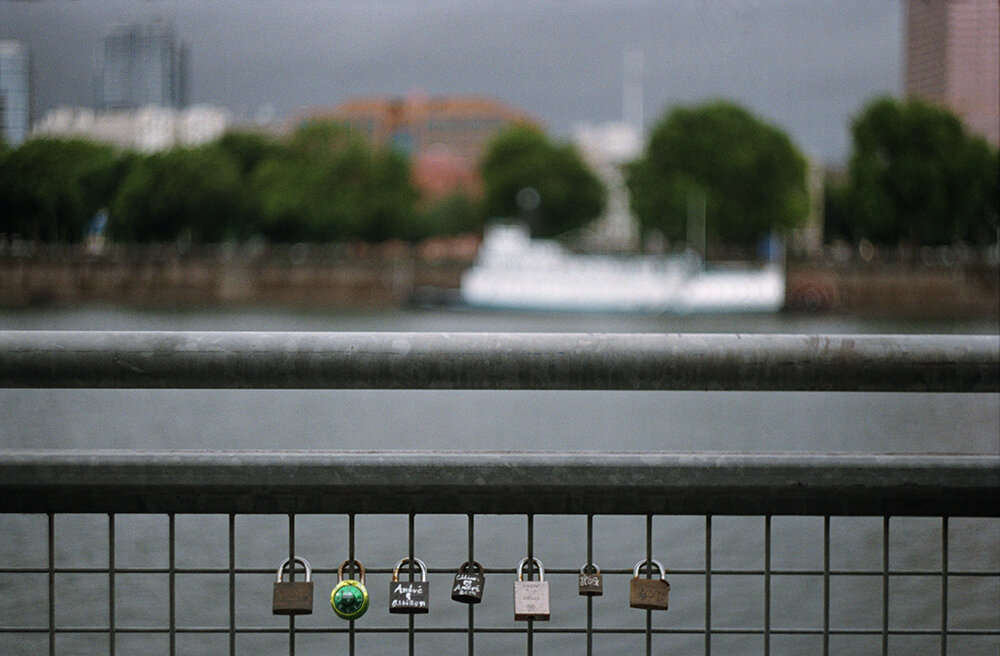Film Friday - December 5th, 2025. Kodak ColorPlus 200 Film Review
Today’s Film Friday takes a look at a blast from the past: Kodak ColorPlus 200. This all-purpose film is one of the most affordable color negative films available for loading into your favorite 35mm film camera. It is very much a jack-of-all-trades type of film (and a master of none) that will do everything you want it to decently well and save your camera budget in the process. So let’s get started.
One of the most interesting aspects to Kodak ColorPlus 200 is its history. What is in that yellow and red box, exactly? Where did this film come from? What is it’s lineage? We love delving into the history of the films we feature on here because we feel like it helps broaden our understanding of them as we use them in the present. Kodak ColorPlus 200 has a bit of a murky and mysterious background. What we have to share is a mix of internet research and educated guesswork but here goes.
More than likely ColorPlus 200 is a branch off the same tree as Kodak Gold 200, with both of these films descended from the Kodacolor VR films of the early 1980s. Kodacolor VR, for its part, was an update on the previous Kodacolor II line that had been one of Kodak’s mainstay films of the 1970s. As an interesting side note, when Kodak was in the business of producing Disc film, many of their newest, cutting edge film technologies were tested in the Disc format first and then carried over into the other formats. Kodak released its HR Disc film in 1982 that had major improvements to film grain, contrast, color accuracy, image stability and the like. HR film then migrated over into the 35mm format as Kodacolor VR film. By 1987, improvements to this film’s emulsion had produced the Gold films. It is here that the fates of ColorPlus and Kodak Gold 200 seem to diverge. While the Gold line continued on, particularly in the North American market, ColorPlus (also known simply as Kodacolor 200, ColorPlus was not adopted as a name until the late 1990s or early 2000s) remained a frozen-in-time snapshot of the line and was marketed more heavily in the Asian market.
If this speculation is accurate, then you can think of ColorPlus as a fairly close relative to Kodak Gold 200 film, albeit one with more of a throwback attitude and look.
Kodak ColorPlus’ retro look is great for retro subjects.
Be this film’s history as it may, let’s now get into what it can do for you and your cameras today. At the risk of painting ColorPlus as a “cheap” film, perhaps the biggest characteristic about this film worth pointing out is its very budget-friendly price. It is the cheapest color film on the market at the time of this writing. And that is a big deal. Film photography is expensive, and only gets more so each year. A roll of Portra will set you back roughly $15, treating yourself to some Fuji Velvia is akin to a gourmet hamburger or a decent meal out. But ColorPlus won’t hit your wallet nearly as hard. In fact it comes in at just over half the price of that aforementioned Portra. That means you can almost buy twice the amount of film, and as film photographers we always need more film.
But despite it featuring a budget price, don’t let that lead you into thinking this is a cheap film when it comes to image quality. Kodak ColorPlus does better at everything than you likely expect it to, and while it may not perform at the same high levels as Portra or Ektar, for a film that costs almost half the price, it certainly does far better than half as good a job.
Kodacolor VR was one of Kodak’s first color negative films to inherit T-grain technology. As a descendant of that early film, Kodak ColorPlus has carried forward some pretty fine grain and sharp detail. Yes, it is a consumer film. Yes, it very well might not have received an emulsion technology update in the last 30 years, yes it is only available in 35mm, but even with all those factors in mind, you will be surprised at how little film grain you see with ColorPlus. The images it makes are clean and surprisingly crisp.
This is an image that helps show off ColorPlus’ grain, or lack of, quite well.
Right up there with grain in terms of defining qualities is ColorPlus’ palette. A film’s color is always a bit of a tricky thing to pin down since there are so many variables that can affect it, including but not limited to: the type of lens you use, how you expose the film, its developing, the quality of the scanning and finally any post-processing or filtering applied after the fact. So we always approach the color of the film with a bit of caution, or rather an acknowledgement that mileage may vary depending on other aspects of your process. Having said, we’d describe ColorPlus’ palette as kind of old school. It has softer colors, that at the same time don’t look flat at all and have decent richness to them. They are not nearly as vibrant as say, Kodak Ektar 100, or contemporary digital photography. But that gives ColorPlus an appeal all its own. It has a look that hearkens back to the softer, almost pastel, colors of 1980s film technology. Kodak ColorPlus does seem to favor its warmer colors. It’s reds and pinks pop just a bit more than its blues and greens do. Overall though, the film brings a nice, deft touch to its colors.
A nice cross-section of Kodak ColorPlus’ color palette.
Hand in hand with color is contrast, and much like color, the contrast of ColorPlus is low key. The film is not flat, but it does a very gentle job with shadows to highlights. In our opinion, this is generally preferable as it is easier to add contrast to a film via pushing the development or in scanning and post-production than it is to remove contrast. If you line a ColorPlus image up next to one made on Portra or Ektar, you will notice the difference right away. ColorPlus has much shallower shadows and it does a decent job of maintaining its highlights as well. Overall, the film won’t produce images that pop off the print at you, but if you know that going in, and in particular if you use this film in brighter, more contrasty light, you will find yourself really appreciating this aspect of ColorPlus. It is a question of nuance versus drama, and ColorPlus loves its nuance.
Lastly, ColorPlus offers reasonable latitude as well. Many users of ColorPlus find they prefer shooting the film at ISO 100 and in reality the film will easily absorb that extra stop of overexposure and continue to deliver clean, crisp images for you. As with most color negative films, you could probably err even farther with ColorPlus and over-expose by as much as 2-3 stops before you notice dramatic changes to how the film renders. On the under-exposure side you probably want to keep the film within the 1 stop range. Again, most color negative films have less tolerance for under-exposure and ColorPlus is no different. If in doubt, give this film more light rather than less.
We were a bit worried as to how the murals on the side of this walkway would expose given the difference in the lighting. At the same time, we didn’t want to blow out the foliage dead ahead. We metered for the trees and opened up about a half stop from there and ColorPlus turned in a really decent exposure of the scene.
Let’s recap and sum it all up now. In short, Kodak ColorPlus is a budget-friendly film that is great when you want to shoot a bit of this, a bit of that, and whatever happens in between. It work as well in your Nikon F3 as it will in your Olympus Stylus. It is a great film to have in a pinch or in a moment of indecision. And while you will produce sharper, more saturated landscapes with Kodak Ektar or cleaner portraits with Kodak Portra, ColorPlus fits in between those professional films quite well and fills the gaps quite nicely. If you spent six months shooting nothing but ColorPlus we daresay you would barely miss those other films. So be it city streets, snapshots of loved ones, quiet moments at home, or road trips through gorgeous landscapes, keep a couple rolls of ColorPlus handy. You won’t regret it.
We have almost every film stock available on the market. Check it out!
If you need an excellent lab for meticulous film developing, topnotch optical prints, traditional darkroom printing and superb film scanning, we’re your lab!
Also, sign up for our weekly newsletter The Loupe and keep your eyes peeled on our social media feeds every Friday when we feature a different film and also offer it at a one day discount of 15% off!


















